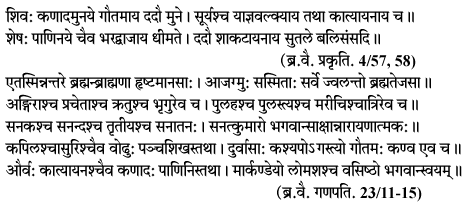 |
(60) Period of
Panini and the Sutras,
the Sages and Saints who were
produced by Brahma; and the Smritis.
Period of Panini and the Sutras.
European writers have created a lot of confusion in our
historic dates and their blind followers have mindlessly swayed themselves
in that flow of ignorance without even checking the authentic records of
our own scriptures. Let us see the reality.
Sage Vashishth has referred to Ashwalayan and
Shankhayan in his Dharm Sutra. Sage Bodhayan has referred to Sage Gautam
in his Dharm Sutra. Sage Panini has referred to Sage Apastamb in the
bidadi-gan-path,
 of his Ashtadhyayi. Baudhayan’s
Dharm Sutra is one of the oldest ones and Gautam was before that.
According to these references Ashwalayan and Shankhayan were before
Vashishth, and Apastamb was prior to Panini. These are the main figures.
If we could discover the period of Panini, Gautam and Vashishth, we can
easily make out the period of others. Now look to the scriptural records.
of his Ashtadhyayi. Baudhayan’s
Dharm Sutra is one of the oldest ones and Gautam was before that.
According to these references Ashwalayan and Shankhayan were before
Vashishth, and Apastamb was prior to Panini. These are the main figures.
If we could discover the period of Panini, Gautam and Vashishth, we can
easily make out the period of others. Now look to the scriptural records.
The Brahmvaivart Puran is one of the prestigious
Puranas. It says,

The first two verses mention that Panini, Bharadwaj and
Shaktayan were in the same period. The second five verses give the names
of 28 Sages who were in the same period. It includes Panini,
Sankadik, Atri, Angira, Bhrigu, Mareechi, Kanad, Lomash, Kapil, Markandeya,
Katyayan, Gautam, Vashishth, Kashyap and Durvasa etc.
Now we know that all the important Sages who produced
the Sutras were contemporaries. It is a fact that the Sages Vashishth,
Gautam and Bharadwaj were during the time of Bhagwan Ram, 18 million years
ago who are said to be the contemporaries of Panini in the first two
verses.
Jacobi’s astrological calculations tell that 2780 BC
could be the period of Sutras and 4500 BC for the Vedas. According to
him the Vedas were produced 2,720 years earlier than the Sutras. Sage
Shaunak’s branch of Atharvaved is still available. His pupils Ashwalayan
and Katyayan produced Shraut Sutra which is also available. It is
discussed earlier in the ‘Age of the Vedas’ that the astrological
situations are a perpetually occurring event at the close of every
astrological cycle of the stars. So it could also have been billions of
years ago. In the same topic it is also established that the Vedas along
with all of their affiliates (Upvedas and Vedangas) and the Puranas etc.
were originally conceived by the Sages 155.5 trillion years ago. Then
again, 1,900 million years ago when the human generation again started,
all of these scriptures were reproduced by the Sages of Bharatvarsh. First
they produced the Vedas, then the Upvedas, then the Sutras and then the
Puranas. So a couple of thousand years of difference between the
reproductions of the Vedas and the Sutras (called the Vedangas) is not a
significant issue. But it all happened 1,900 million years ago. In
this way, just like the Vedas, the Sutras are also eternal. They were not
created by the Sages, they were simply reproduced by the Sages so they are
referenced to by their names.
The eternity of Sages and Saints who were produced by Brahma.
Sage Panini’s name (in the above reference of
Brahmvaivart Puran) has come along with the names of Sankadik, Atri,
Angira and Mareechi who were originally produced by the mind of Brahma
155.5 trillion years ago, in the very beginning of the creation of this
brahmand. It shows that Panini is also an eternal Saint.

The Bhagwatam says that Brahma first produced the four
gyani Saints, Sanak, Sanandan, Sanatan and Sanatkumar, called the
Sankadik.

Then he produced 10 more Sages (called the manas
putra). Their names are: Atri, Angira, Pulastya, Mareechi, Pulah,
Kratu, Bhrigu, Vashishth, Dakch and Narad.
The Brahmvaivart Puran in chapter 22 (Brahm Khand)
mentions the names of some more Sages who were produced by him. Brahma
then produced Swayambhuva Manu and Shatroopa.
Smritis.
Smritis* are the books of codes related to the
social living. They describe what are the sins and the good deeds, define
what penances, or what kind of fasting, or what kind of charity could
redeem which sin, or what should be the punishment for a particular sin.
They also describe what kind of rites and rituals a person is supposed to
observe in the family, and what is the right conduct and right behavior
for the people of various orders of life in the society, and so on. A lot
of Sages and eternal Divine personalities have written Smriti books. Out
of these Manu Smriti, Yagyavalkya Smriti and Parashar Smriti
are important. Parashar Smriti is suitable for the people of kaliyug,
but the other Smritis are suitable for other yugas. However, the
last verse of Parashar Smriti says,

which means that a person who is desirous for
celestial pleasures should study this. It means that it is not directly
related to God realization.
* Eighteen Smritis: Manu, Brihaspati,
Dakch, Gautam, Yam, Angira, Yogishwar, Pracheta, Shatatap, Parashar,
Samvart, Ushna, Shankh, Likhit, Atri, Vishnu, Yagyavalkya
and Harit.
Upsmritis:
Narad, Pulah, Garg, Pulastya, Shaunak,
Kratu, Baudhayan, Jatukarn, Vishwamitra, Pitamah, Jabali, Skand, Logakchi,
Kashyap, Vyas, Sanatkumar, Janak, Vyaghra, Katyayan, Kapinjal, Apastamb,
Kanad, Deval, Paithinasi, Gobhil, Vashishth, Bharadwaj, and more.
Only
some of them are available.

|
 |
 |